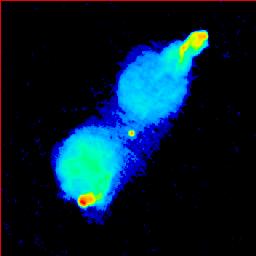 Image:
Image:
3C 390.3 serves as several prototypes rolled into one. It is one of the
nearest examples of a classical double DRAGN, and shows one of the definitive
double hotspots in the NW lobe. It is also one of the best-studied Broad-Line
Radio Galaxies, essentially a nearby quasar
(c.f. 3C 382). Its optical spectrum shows
one of the best examples
of twin-peaked broad-line emission, which is likely to be produced by the
outer regions of an accretion disc in the centre of the
AGN. VLBI observations of the nucleus
(Alef et al. 1988,
1996)
reveal a superluminal jet towards the NW,
in the same direction as a very faint large-scale jet found
by Leahy & Perley (1995), (which is not clearly visible in the
intermediate-resolution image shown here).
The jet feeds into the recessed, compact component of the
double hotspot, which is connected to the outer component by a much brighter
jet segment.
All the data is consistent with the DRAGN making a fairly small angle
(20° - 30°) to the line of sight, meaning that the nearer (NW) side
is seen around 2 million years later than the far side, just because the
light from the far side has further to travel. Leahy & Perley speculate
that many of the differences between the two sides could be caused by
this time lag, with the contrasting hotspots in the two lobes showing two
different stages of the impact on the lobe boundary
of a particularly powerful pulse of jet emission.
Page created: 2009 Apr 2 14:16:43
J. P. Leahy
jpl@jb.man.ac.uk
 Image:
Image: